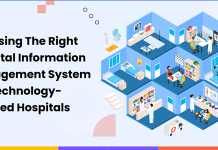The overly optimistic belief that “it won’t happen to us” is the biggest cybersecurity mistake a business can make. The risks of data breaches, system hacks, malware attacks, and ransomware attacks are the same for every organization.
Companies in high-target industries face different threats, and there is a higher risk profile. We will discuss the high-target industries below.
You are worried about the safety of your company’s email security. Hackers are constantly trying to break into your company’s email. Use primasecure, a cloud-based email security system, to protect your company from hackers!
Industry Sectors Targeted By Cyber Attacks
Business and medical/healthcare organizations were most frequently impacted by data breaches from 2014 until the first half of 2018.
The majority (309) of the 688 breaches reported to Statista in the first half of 2018 occurred in business, while 181 affected healthcare. Government and military were the final two top targets with 49 and 45 breaches, respectively, in banking, credit, and financial organizations (84 breaches).
Also on the trending list are the energy and utility industry. Each of these six areas has its type of threat, and these target areas are:
- Utilities/Energy
- Educational Institutions
- Military/Government
- Financial/Banking/Credit
- Medical/Health
- Businesses
-
Utilities/Energy
Particular concerns are facing the energy and utility sectors. Hacktivism and cyberterrorism are both common in this very regulated sector, even with tough regulations and laws in place. There are usually miles of space between their equipment, and motivated hackers can cause widespread power outages that can threaten millions of citizens and infrastructure.
We are powered by the electricity grid and utilities. A large number of mobile connections in this area pose a potential threat for malware infection (web, mobile, and network security are all critical). The restoration of backups is also important.
-
Educational Institutions
Several reasons lead to the targeting of schools:
- Campus research yields valuable intellectual property.
- Individual student and employee data.
- For manipulating data processing.
Moreover, universities have a high turnover in student populations, which can lead to poorly protected passwords and vulnerability to social engineering.
With a total of 539 breaches affecting nearly 13 million records from 2005 to 2015, higher education was one of the most brutally hit. An article by Gemalto later stated that the number of stolen, lost, or compromised data records rose by 164 percent from the end of 2016 to the end of 2017.
-
Military/Government
It’s unlikely that you’d be surprised to see government and military security breaches on this blog as these concerns tend to be high-profile. In this sector, the following entities are involved:
- Spyware or harm to competitive companies by foreign countries.
- Activists seeking to cause a political stir through hacking.
- Criminals exploit public databases to harvest personal information.
Defense Department announced its cyber strategy for fighting and winning wars across all domains, including cyberspace, in September of 2018. Essentially, this strategy informs the United States military how to fend off malicious cyber activity that attacks critical U.S. infrastructure and may result in major cyber incidents.
-
Financial/Banking/Credit
There are obvious reasons for targeting this industry. Ultimately, hackers are primarily interested in money and personal information when they target these organizations.
One in three financial institutions is successfully attacked each year (at an average of 85 compromise attempts per year), according to a 2016 Accenture survey.
Financial institutions must abide by regulations regarding penetration testing. Financial institutions, including banks, credit unions, and credit unions, must implement controls to avoid illegal access to customer information and securely discard information related to consumers and customers.
-
Medical/Health
A frequent target of this data-intensive industry is its information-intensive nature. A large amount of personal and financial details are included in electronic health records kept by health care and medical organizations.
According to the BBC, WannaCry ransomware attacks have negatively affected patient care at England’s National Health Service (NHS). Healthcare entities need to lock down their networks and systems to comply with laws and protect electronically protected health information (ePHI). Despite the industry’s strict standards designed to identify exploitable vulnerabilities, vulnerabilities still exist in healthcare networks.
-
Businesses
The fact that most threats can be classified in this broad category is understandable.
For example, take e-commerce/retail into account. Observers contend that omnichannel access and supply chain networks hold a wealth of sensitive financial and personal information about these companies.
The situation is also dire for small businesses. Small-scale companies often do not have the resources or priority to secure their networks from cyberattacks, while large organizations prefer to invest in cybersecurity.
Meanwhile, from April 2016 to May 2017, 14 million small businesses were hacked.
What Are The Best Ways To Protect My Organization From Cyberattacks?
All industries in the modern era need to protect their assets and data from cyberattacks, which are becoming more frequent. For your organization’s protection, consider these tips:
-
1. Analyze Vulnerabilities Related To Cyber Security.
An assessment of vulnerabilities in your organization will identify weaknesses that need to be fixed and suggest how to do so.
-
Verify The Security Of Your Wireless Network.
The following are some tips for securing your Wi-Fi:
- Put in a WPA2 address.
- On new devices, modify the admin password.
- Turn off the service set identifier broadcast on the wireless access point.
- Keep away from Wired Equivalent Privacy (WEP) at all costs.
- Maintain a separate network for your business and your customers.
- Adopt artificial intelligence (AI).
A variety of cyber threats can be tracked and analyzed using AI to help you find and prioritize risks, respond effectively to incidents, and avert malware attacks.
-
Don’t Grant Access To All Information.
Information security threats for businesses are primarily caused by human error. Using only the systems and information your employees need for their jobs will help you reduce your risk.
-
Set Up Firewalls.
If employee computers, smartphones, and networked devices are all updated with the latest firewall software, they can help block potential hackers.
-
Making Sure Your Employees Are Well Trained.
The best way to reduce the threat of cybercrime is to educate your employees. Security policies guide employees on how to manage data, emails, or internet sites safely.
-
Get IT Professionals To Help You.
Today, most organizations require experts to guard their data and prevent hackers from reaching their systems. While there are more of these professionals needed than there are available, the demand for them has significantly increased.
Cybersecurity jobs in the U.S. are currently unfilled over half a million, and this number is expected to rise substantially by 2021. These are lucrative positions, and many of them are available. Those with an IT degree and certification can expect to earn even more with a salary of $90,000, according to (ISC) 2.
The Takeaway!
Overall, hackers are interested in specific vulnerabilities more than specific industries.
With virtually every industry facing a variety of risks, companies should follow best practices such as keeping their software up to date, enabling two-factor authentication, and backing up their data regularly. Last but not least, they should use quality antivirus software to prevent cyberattacks. Testing for vulnerabilities and threats in your organization can also provide you with information.
Author Bio
Neha Singh is the Founder & CEO of Securium Solutions with a demonstrated history of working in the information technology and services industry. She is skilled in ECSA, Vulnerability Management, Security Information and Event Management (SIEM), Management, and Business Development. She loves traveling and trekking.





















